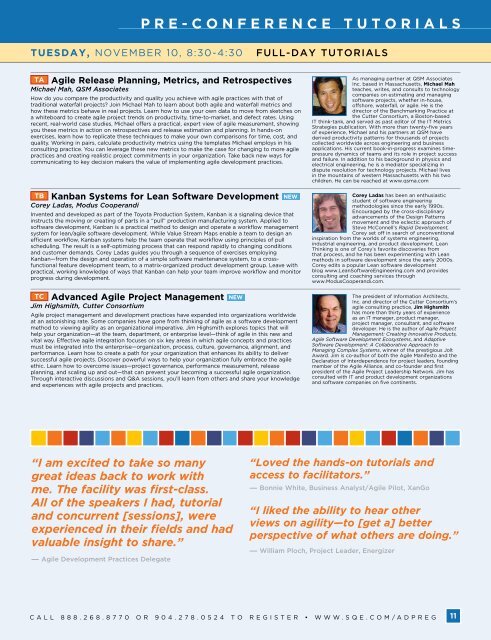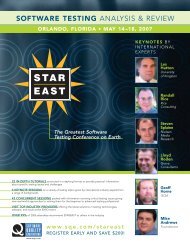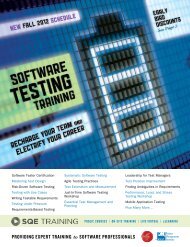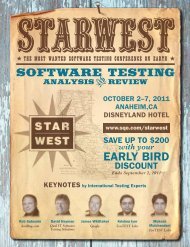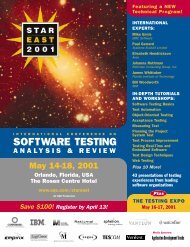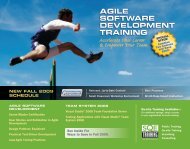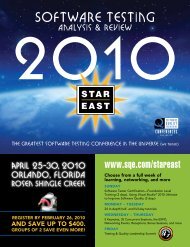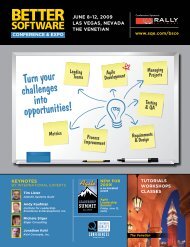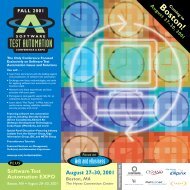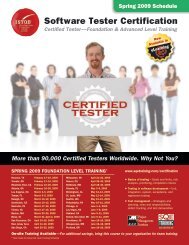pre-conference tutorialsMONDAY, november 9, 1:00-4:30 half-DAY AFTERNOON TUTORIALSMI ADAPTing to <strong>Agile</strong>: A Guide to TransitioningMike Cohn, Mountain Goat SoftwareTransitioning to an agile development process is unlike most transitions development organizationsmake. Often, transitions begin when a strong, visionary leader plants a stake in the ground and says,“Let’s take our organization there.” Other transitions start with a lone team thinking, “Who careswhat management thinks, let’s do this.” The problem in transitioning to agile is that neither of theseapproaches is likely to lead to the long-term, sustainable change you want. Mike Cohn describeshow you can iterate toward more agility by <strong>com</strong>bining a senior-level “guiding coalition” with multiple“action teams.” Along the way, you will learn the acronym ADAPT to describe the five steps necessaryfor any successful agile transition: Awareness, Desire, Ability, Promote, and Transfer. Explore thereal role of leaders and managers in guiding self-organizing teams toward agility. Take back provenpatterns for getting started—Start Small, Stealth Mode, Going All In, Public Displays of Agility,Impending Doom, and more. Leave knowing what you must—and must not—do to succeed with agilein your organization and team.MJ Tuning and Improving Your Agility: Getting MoreDone NEWDavid Hussman, DevJamIf you consider yourself an experienced agile practitioner and you’re looking to improve your skills,this tutorial is for you. David Hussman presents tools for evaluating your team’s agility and useof various agile practices. David teaches tools used by successful agile <strong>com</strong>munities who havelearned the value of continually evolving their practices as well as experiences with <strong>com</strong>munitieswho lost sight of the underlying value practices provide and chose to overfocus on mechanics.David’s approaches tuning your agility in four essential areas: growing <strong>com</strong>munity and vision,planning products, incremental delivery of value, and the deeper challenges around continuousimprovement. Join the party and learn how to get more done with your existing processes as wellas learn new techniques and tools which draw from the core agile tenets, the source of on-goingsuccess and ever-increasing agility.MK Practicing ScrumBut: Ensuring Project Failures NEWMitch Lacey, Mitch Lacey & Associates, Inc.Scrum appears deceptively simple, but an effective implementation is <strong>com</strong>plicated. Scrum’s rulesare simple to understand, but organizations often ignore basic Scrum principles claiming they are“different” and don’t need to “follow all the rules.” Listen for the phrase, “We do Scrum, but …” Oneof the most <strong>com</strong>mon examples is, “We do Scrum, but we hold our daily stand-up meetings onlyonce a week.” The purpose of the daily meeting is to allow the team to sync daily, track their priorday’s progress, update their daily plan, and identify impediments. Pushing this off to a once-a-weekmeeting clouds status, hides difficulties, and causes problems to persist longer, slowing the teamand delaying the project. Inevitably, it will be the “but” that prevents the organization from achievingits greatest productivity. Mitch Lacey describes <strong>com</strong>mon ScrumButs and ways to extinguish themfrom your team and organization. In this interactive session, you’ll have a chance to share your ownScrumButs and explore ways to fix them next Monday.A Certified Scrum trainer, Mike Cohn isthe founder of Mountain Goat Software,a process and project managementconsultancy and training firm. He is theauthor of newly published Succeedingwith <strong>Agile</strong>: Software <strong>Development</strong> usingScrum, <strong>Agile</strong> Estimating and Planningand User Stories Applied for <strong>Agile</strong>Software <strong>Development</strong>, as well as books on Java and C++programming. With more than twenty years of experience,Mike has previously been a technology executive in<strong>com</strong>panies of various sizes—from startup to Fortune 40.A frequent magazine contributor and conferencespeaker, Mike is a founding member of the ScrumAlliance and the <strong>Agile</strong> Alliance. He can be reached atmike@mountaingoatsoftware.<strong>com</strong>.David Hussman has years of experiencecoaching and leading a wide variety ofsoftware <strong>com</strong>munities—digital audio,digital biometrics, medical, government,legal, security, industrial, financial, retail,and education to name a few. David nowteaches and coaches the growth of agilityin project <strong>com</strong>munities worldwide. He isco-author of Produce It and contributor to several booksincluding Managing <strong>Agile</strong> Projects and <strong>Agile</strong> in the Largeand various other publications. David leads DevJam, agroup of mentors and practitioners who focus on usingagile methods to help people and <strong>com</strong>panies improvetheir software production skills. DevJam (www.devjam.<strong>com</strong>) provides seasoned coaches, teachers, and leaderswho strive to pragmatically match technology, people, andprocesses to create better and cooler products.Mitch Lacey has managed numerous plandrivenand agile projects over the pasttwelve years. At Microsoft Corporation,Mitch honed his agile skills, successfullyreleasing core enterprise services forWindows Live, and transitioned fromprogram manager to <strong>Agile</strong> Coach,helping others in their transition to agilepractices. He later became the <strong>Agile</strong> Practice Manager atAscentium Corporation where he coached customers onagile practices and adoption worldwide. As a CertifiedScrum Trainer (CST) and a registered Project ManagementProfessional (PMP), Mitch shares his experience in projectand client management through Certified ScrumMastercourses, agile coaching engagements, conferencepresentations, and his writings, including Scrum: A SurvivalGuide, to be published in early 2010.ML User-Centered <strong>Agile</strong> Software <strong>Development</strong> NEWJeff Patton, Independent ConsultantMany agile processes focus on building more functionality faster and as a resultoverlook characteristics such as “easy to use,” “desirable,” and “meets my goalsas a user.” Jeff Patton presents the essentials of creating a truly user-centric agileprocess—one that helps you gain insight into your users’ true needs, allowing you toleverage them and create useful, usable, and desirable software products. In shortpractice sessions, Jeff walks you through building pragmatic user personas and writinguser stories that describe the user’s experience. Explore how to ideate user interfaceconcepts and quickly identify solutions that deliver the desired functionality. Learn howto assess and improve usability, and discover how design esthetics contribute to overalluser satisfaction. Come away with new ways to integrate users into the developmentprocess—with the goal of delivering software that will wow your users, product owners,and all stakeholders.Jeff Patton has designed and built software for the pastfifteen years on a wide variety of products from on-lineaircraft parts ordering to electronic medical records. Jeffhas focused on agile approaches since working on anearly Extreme Programming team in 2000. In particularJeff has specialized in the application of user experiencedesign practice to improve agile requirements, planning,and ultimately the products delivered. Jeff currentlyworks as an independent consultant, agile process coach, product designprocess coach, and instructor. Current articles, essays, and presentationson variety of topics in agile product development can be found at www.<strong>Agile</strong>ProductDesign.<strong>com</strong> and in Alistair Cockburn’s Crystal Clear. Jeff isfounder and list moderator of the agile-usability Yahoo discussion group,a columnist with StickyMinds.<strong>com</strong> and IEEE Software, a Certified ScrumTrainer, and winner of the <strong>Agile</strong> Alliance’s 2007 Gordon Pask Awardfor contributions to <strong>Agile</strong> <strong>Development</strong>. Website including writing, pastpresentations, and blog: www.agileproductdesign.<strong>com</strong>MM Release Planning: A Strategy for Success NEWDan Rawsthorne, Danube TechnologiesOne of the primary responsibilities of the product owner and project teams is release planning.Stakeholders want, need, and deserve to know what they’ll be getting—and when. How do you dothis in an agile environment? Although many find it tempting to create a release plan as a seriesof sprint plans, this is a mistake. It violates the lean principle of “minimal inventory” and will mostlikely be wrong—the same as with traditional project planning. Release planning is actually thedevelopment of a release strategy that is refined and adjusted throughout the process. A releasestrategy defines capabilities (not stories) and often includes a game plan for “spending” storypoints (or effort or money) to produce the most value. Dan Rawsthorne presents “rules of thumb”for developing a release strategy and spending game plan. You’ll practice using these rules duringa guided exercise, walk through an example release, and learn how to monitor and measure therelease plan along the way.A software developer for more thantwenty-five years, Dan Rawsthorneis an ac<strong>com</strong>plished manager, mentor,coach, trainer, consultant, and architect.His experience runs the gamut—frome-<strong>com</strong>merce to databases to militaryavionics and air traffic control. Dan is anagent of change, helping organizationstransform themselves through liberal applications of<strong>com</strong>mon sense and agile techniques. His formal trainingcauses him to look for underlying problems rather thanfocusing on surface symptoms; his military backgroundhelps him understand the importance of teamwork andempowerment; and his <strong>com</strong>mon sense tells him that changemust happen in small manageable bites. Dan is currentlyco-writing Advanced Topics in Scrum, due out in 2009.10Call 888.268.8770 or 904.278.0524 to register • WWW.<strong>SQE</strong>.COM/ADPREG
pre-conference tutorialsTUESDAY, november 10, 8:30-4:30FULL-DAY TUTORIALSTA <strong>Agile</strong> Release Planning, Metrics, and RetrospectivesMichael Mah, QSM AssociatesHow do you <strong>com</strong>pare the productivity and quality you achieve with agile practices with that oftraditional waterfall projects? Join Michael Mah to learn about both agile and waterfall metrics andhow these metrics behave in real projects. Learn how to use your own data to move from sketches ona whiteboard to create agile project trends on productivity, time-to-market, and defect rates. Usingrecent, real-world case studies, Michael offers a practical, expert view of agile measurement, showingyou these metrics in action on retrospectives and release estimation and planning. In hands-onexercises, learn how to replicate these techniques to make your own <strong>com</strong>parisons for time, cost, andquality. Working in pairs, calculate productivity metrics using the templates Michael employs in hisconsulting practice. You can leverage these new metrics to make the case for changing to more agilepractices and creating realistic project <strong>com</strong>mitments in your organization. Take back new ways for<strong>com</strong>municating to key decision makers the value of implementing agile development practices.TB Kanban Systems for Lean Software <strong>Development</strong> NEWCorey Ladas, Modus CooperandiInvented and developed as part of the Toyota Production System, Kanban is a signaling device thatinstructs the moving or creating of parts in a “pull” production manufacturing system. Applied tosoftware development, Kanban is a practical method to design and operate a workflow managementsystem for lean/agile software development. While Value Stream Maps enable a team to design anefficient workflow, Kanban systems help the team operate that workflow using principles of pullscheduling. The result is a self-optimizing process that can respond rapidly to changing conditionsand customer demands. Corey Ladas guides you through a sequence of exercises employingKanban—from the design and operation of a simple software maintenance system, to a crossfunctionalfeature development team, to a matrix-organized product development group. Leave withpractical, working knowledge of ways that Kanban can help your team improve workflow and monitorprogress during development.TC Advanced <strong>Agile</strong> Project Management NEWJim Highsmith, Cutter Consortium<strong>Agile</strong> project management and development practices have expanded into organizations worldwideat an astonishing rate. Some <strong>com</strong>panies have gone from thinking of agile as a software developmentmethod to viewing agility as an organizational imperative. Jim Highsmith explores topics that willhelp your organization—at the team, department, or enterprise level—think of agile in this new andvital way. Effective agile integration focuses on six key areas in which agile concepts and practicesmust be integrated into the enterprise—organization, process, culture, governance, alignment, andperformance. Learn how to create a path for your organization that enhances its ability to deliversuccessful agile projects. Discover powerful ways to help your organization fully embrace the agileethic. Learn how to over<strong>com</strong>e issues—project governance, performance measurement, releaseplanning, and scaling up and out—that can prevent your be<strong>com</strong>ing a successful agile organization.Through interactive discussions and Q&A sessions, you’ll learn from others and share your knowledgeand experiences with agile projects and practices.As managing partner at QSM AssociatesInc. based in Massachusetts, Michael Mahteaches, writes, and consults to technology<strong>com</strong>panies on estimating and managingsoftware projects, whether in-house,offshore, waterfall, or agile. He is thedirector of the Benchmarking Practice atthe Cutter Consortium, a Boston-basedIT think-tank, and served as past editor of the IT MetricsStrategies publication. With more than twenty-five yearsof experience, Michael and his partners at QSM havederived productivity patterns for thousands of projectscollected worldwide across engineering and businessapplications. His current book-in-progress examines timepressuredynamics of teams and its role in project successand failure. In addition to his background in physics andelectrical engineering, he is a mediator specializing indispute resolution for technology projects. Michael livesin the mountains of western Massachusetts with his twochildren. He can be reached at www.qsma.<strong>com</strong>Corey Ladas has been an enthusiasticstudent of software engineeringmethodologies since the early 1990s.Encouraged by the cross-disciplinaryadvancements of the Design Patternsmovement and the eclectic approach ofSteve McConnell’s Rapid <strong>Development</strong>,Corey set off in search of unconventionalinspiration from the worlds of systems engineering,industrial engineering, and product development. LeanThinking is one of Corey’s favorite discoveries fromthat process, and he has been experimenting with Leanmethods in software development since the early 2000s.Corey edits a popular Lean software developmentblog www.LeanSoftwareEngineering.<strong>com</strong> and providesconsulting and coaching services throughwww.ModusCooperandi.<strong>com</strong>.The president of Information Architects,Inc. and director of the Cutter Consortium’sagile consulting practice, Jim Highsmithhas more than thirty years of experienceas an IT manager, product manager,project manager, consultant, and softwaredeveloper. He is the author of <strong>Agile</strong> ProjectManagement: Creating Innovative Products,<strong>Agile</strong> Software <strong>Development</strong> Ecosystems, and AdaptiveSoftware <strong>Development</strong>: A Collaborative Approach toManaging Complex Systems, winner of the prestigious JoltAward. Jim is co-author of both the <strong>Agile</strong> Manifesto and theDeclaration of Interdependence for project leaders, foundingmember of the <strong>Agile</strong> Alliance, and co-founder and firstpresident of the <strong>Agile</strong> Project Leadership Network. Jim hasconsulted with IT and product development organizationsand software <strong>com</strong>panies on five continents.“I am excited to take so manygreat ideas back to work withme. The facility was first-class.All of the speakers I had, tutorialand concurrent [sessions], wereexperienced in their fields and hadvaluable insight to share.”— <strong>Agile</strong> <strong>Development</strong> <strong>Practices</strong> Delegate“Loved the hands-on tutorials andaccess to facilitators.”— Bonnie White, Business Analyst/<strong>Agile</strong> Pilot, XanGo“I liked the ability to hear otherviews on agility—to [get a] betterperspective of what others are doing.”— William Ploch, Project Leader, EnergizerCall 888.268.8770 or 904.278.0524 to register • WWW.<strong>SQE</strong>.COM/ADPREG 11
- Page 2: Agile DevelopmentPractices Conferen
- Page 5 and 6: wednesday, november 118:309:4510:00
- Page 7 and 8: conference speakersKeynoteSpeakerTu
- Page 9: pre-conference tutorialsMONDAY, nov
- Page 13 and 14: pre-conference tutorialsTUESDAY, no
- Page 15 and 16: Agile Testing Workshop Sessionsmond
- Page 17 and 18: keynote sessionsMONDAY, may 16, 8:3
- Page 19 and 20: concurrent classesMONDAY, may 16, 8
- Page 21 and 22: concurrent classesMONDAY, may 16, 8
- Page 23 and 24: concurrent classesMONDAY, may 16, 8
- Page 25 and 26: Agile Leadership Summit Sessionsfri
- Page 27 and 28: sponsors and exhibitorsconference s
- Page 29 and 30: Lean-Agile ScrumMaster TrainingNew
- Page 31 and 32: agile development practices Registr


